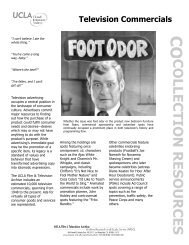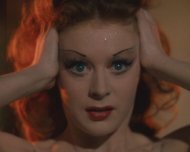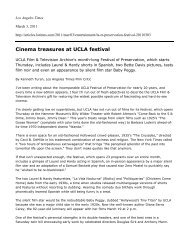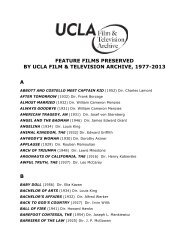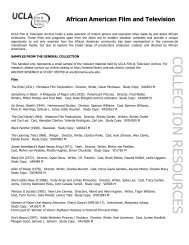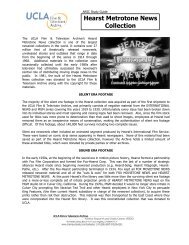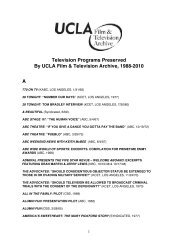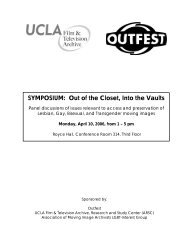"Heroic Grace" catalog - UCLA Film & Television Archive
"Heroic Grace" catalog - UCLA Film & Television Archive
"Heroic Grace" catalog - UCLA Film & Television Archive
You also want an ePaper? Increase the reach of your titles
YUMPU automatically turns print PDFs into web optimized ePapers that Google loves.
Southerners, and that it was only at that point that stories based upon<br />
the legends of Shaolin began to proliferate, with Lau’s 36TH CHAMBER as<br />
the prototype. It is also no accident that these were also the films that<br />
finally sidelined the Woman Warrior, who had played a noble co-paragon<br />
role in the movies of the old school. The qi, apparently, is more democratic<br />
than the bicep. 23<br />
On the other hand it is entirely possible to know too much, to the<br />
point that a fixation upon authenticity for its own sake becomes a distraction—as<br />
in the famous case of the lifelong New Yorker who “gets<br />
thrown out of the movie” if a character travels on the IRT between stations<br />
that are not actually connected. Those who regard themselves as<br />
martial purists insist that the depictions of particular fighting styles<br />
must always be as accurate as possible, and reflexively reject any film<br />
that incorporates “wire work” or special effects, or in which the performers<br />
have no real martial arts training. The success of CROUCHING<br />
TIGER, however, indicates that for mainstream audiences this sort of<br />
martial fundamentalism has little resonance.<br />
Then too, wuxia stories on both page and screen have always<br />
deployed widely varying degrees of realism, as you will see if you stay<br />
with this series from start to finish. Some of these films (like ESCORTS<br />
OVER TIGER HILLS [HUSHAN HANG, 1969] and FROM THE HIGHWAY [LUKE YU<br />
DAOKE, 1970]) hew close to the underlying historical jiang hu realities of<br />
bandits, rebels and bodyguards. Others (like THE SIX-FINGERED LORD OF<br />
THE LUTE (LOKE CHI KAM MOH/LIU ZHI QIN MO, 1965) and Tsui Hark’s ZU:<br />
WARRIORS FROM THE MAGIC MOUNTAIN (SAN SOOK SAN KIM HAP/XIN SHUSHAN<br />
JIANXIA, 1983) are full-bore old school fantasies populated entirely by<br />
rival clans of airborne super-swordsmen and women.<br />
And as is often the case in creative endeavors, the richest specimens<br />
are those that mix elements freely. Stephen Teo notes here that even the<br />
archetypal “new style” wuxia film, King Hu’s COME DRINK WITH ME (DAI ZUI<br />
XIA, 1966), relishes the shock value of introducing old-school magical<br />
fighters into a carefully established context of realistic swordplay modeled<br />
(in part) on Japanese samurai films. 24 And Chu Yuan, in his adaptations<br />
from the hard-boiled wuxia novels of Gu Long, such as KILLER CLANS<br />
(LIUXING HUDIE JIAN, 1976), adopts a wised-up, downright cynical view of<br />
the human motivations of his heroes. But Chu also sets his stories in the<br />
heart of the mythical jiang hu at its most efflorescent, embellishing it<br />
with multi-plane layers of flowers and silks and gilded furnishings, in<br />
gorgeous images that look like Maxfield Parrish paintings come to life.<br />
(The women in the Gu-Chu films, though often relegated to behind-thescenes<br />
roles as amoral schemers, are also lavishly displayed en déshabillé,<br />
their undraped bodies employed, in effect, as additional elements<br />
of his luxuriant décor.)<br />
23 Many films depict a long-running bitter feud between the followers of Wudang and<br />
Shaolin. Song Dynasty scholar Zhang Sanfeng, a student at Shaolin, supposedly left<br />
the Temple around 1000 AD to found a school of his own, at Wudang Mountain in Hubei<br />
province. There he created the inner Northern style par excellence, taiji. The name<br />
“Wudang” means “what the martial arts should be,” which understandably irked some<br />
Shaolin loyalists, who blamed Wudang informers for the burning of the Temple. An<br />
unusual depiction of the relationship is Lau Kar-fai’s (Gordon Liu Jiahui’s) SHAOLIN<br />
VS. WUDANG (SHAOLIN YU WUDANG, 1981), which strikes a conciliatory note: a corrupt<br />
Qing Dynasty official foments conflict between the schools, until the best Shaolin and<br />
Wudang fighters team up to shut him down. See Ng Ho, “When Legends Die,” in Martial<br />
Arts <strong>Film</strong>s, pp. 60-61; additional information from Craig D. Reid.<br />
24 It was the alarming popularity of imported samurai movies in Hong Kong in the<br />
early 1960s, especially those in which Katsu Shintaro portrayed Zatoichi the Blind<br />
Swordsman, that prompted Shaw Brothers to launch its so-called “new school” of<br />
grittier, bloodier wuxia movies. The tavern scene in COME DRINK WITH ME is clearly<br />
modeled on many similar trademark episodes in the Zatoichi canon, and the disabled<br />
warrior played by Wang Yu in Zhang Che’s ONE-ARMED SWORDSMAN (DUBI DAO, 1967)<br />
owes his existence partly to Ichi’s example. Katsu and Wang faced off in person a<br />
few years later in the Hong Kong/Japanese co-production ZATOICHI MEETS HIS EQUAL<br />
(ZATOICHI YABURE! TOJIN-KEN, dir. Yasuda Kimiyoshi, 1971).<br />
8<br />
Even CROUCHING TIGER is a mixed specimen. The ma zei (mounted bandit)<br />
character played by Zhang Zheng, and Michelle Yeoh’s Yu Shulian, the<br />
professional biao shi (security escort/bodyguard), are staple figures of<br />
the down-to-earth school. Yet its heroes can also take off and fly when<br />
the need arises. Even here, though, the fantasy elements are not unadulterated.<br />
“I was trying to express the magical characteristics of shenguai<br />
(“gods and demons”) wuxia,” said the film’s martial arts coordinator, Yuen<br />
Wo-ping. “[But] I still tried to incorporate some realistic touches, so that<br />
the people were not just flying through the air. They can leap high, but<br />
they always have some kind of springboard on the ground.” 25<br />
Like all the great film genres the martial arts movie is a commodious<br />
vessel into which any number of personal styles, attitudes and philosophies<br />
can be poured. In fact, the genre’s almost limitless flexibility is<br />
what has kept it current and enduringly popular for over 50 years,<br />
adapting effortlessly to sweeping changes in its demographic. Heroes<br />
who were staunch Confucian conservatives in the ’50s became youthful<br />
rebels in the ’60s, satirical cut-ups in the ’80s, alienated loners in the<br />
’90s. And the very best martial arts films, like those of King Hu and Chu<br />
Yuan, transcend every finicky distinction between wuxia and kung fu, the<br />
fantastic and the down-to-earth. What they seem to be hinting at is a<br />
form of moral superiority that shines forth in combat as perfection of<br />
style. Not just the power but the elegance and beauty of the movements<br />
become values to be pursued for their own sake, and they can remain<br />
splendid even in defeat.<br />
Movies that celebrate these qualities in their characters while<br />
neglecting them on the level of film-craft lose all credibility. But in the<br />
hands of a master the heroic grace of great filmmaking tells its own<br />
story. It amounts to an additional demonstration of the proposition that<br />
a skill acquired through long practice is, if not a virtue in its own right,<br />
then certainly the product of a virtue. It is at once the end product and<br />
the ultimate expression of the discipline and the strength of character<br />
that were called upon to achieve it. The martial arts movie is, in other<br />
words, both fundamentally populist and irremediably elitist. It celebrates<br />
the triumph not of the fittest or the strongest, but of the most excellent.<br />
copyright @ 2003, David Chute<br />
Thanks to Cheng-Sim Lim, Stephen Teo and Craig D. Reid, for advice and<br />
correction. Your kung fu is the best.<br />
David Chute has held staff positions at Maine Times, The Boston Phoenix<br />
and the Los Angeles Herald Examiner, and has contributed pieces to the<br />
Los Angeles Times, Premiere, Rolling Stone, and LA Weekly, among others.<br />
For <strong>Film</strong> Comment he guest-edited the “midsection” supplements “Made in<br />
Hong Kong” (March-April, 1988) and “Bollywood Rising: A Beginner’s Guide<br />
to Hindi Cinema” (May-June, 2002).<br />
25 Quoted in David Chute, “Martial Artist: Yuen Wo-Ping, action cinema’s puppet master,”<br />
LA Weekly, Dec.15-21, 2000. According to actress Michelle Yeoh, even the characters’<br />
varying degrees of buoyancy have dramatic significance in CROUCHING TIGER:<br />
“Why is it that some people can fly through the sky and some people are always<br />
grounded and will never reach that level? Even in our flying we express the different<br />
stages of enlightenment. Li Mubai (Chow Yun-fat) is the one who flies the easiest and<br />
the fastest. He has gotten to the stage where he is almost enlightened. He has freed<br />
himself as much as he can from all worldly ties. Whereas my character (Yu Shulian),<br />
whenever I sort of flew I always had to bounce off the walls or the rooftops, because<br />
I was more burdened by responsibilities to family and to society. I was the more<br />
grounded person.” Quoted in David Chute, “The Year of the Tiger,” Premiere, Dec. 2000.



